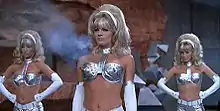Gynoid
A gynoid, or fembot, is a feminine gynomorphic humanoid robot. Gynoids appear widely in science fiction film and art. As more realistic humanoid robot design becomes technologically possible, they are also emerging in real-life robot design.
Name
The term gynoid was first used by Gwyneth Jones in her 1985 novel Divine Endurance to describe a robot slave character in a futuristic China who is judged by her beauty.[1]
A gynoid is anything that resembles or pertains to the female human form. Though the term android has been used to refer to robotic humanoids regardless of apparent gender, the Greek prefix "andr-" refers to man in the masculine-gendered sense.[2] Because of this prefix, Android can be read as referring specifically to male-styled robots.[1][3][4][5][6]
The portmanteau "fembot" (feminine robot) was popularized by the television series The Bionic Woman in the episode "Kill Oscar" (1976)[7] and later used in the Austin Powers films,[8] among others. "Robotess" is the oldest female-specific term, originating in 1921 from Rossum's Universal Robots, the same source as the term "robot".
Gynoid is also used in American English medical terminology as a shortening of the term gynecoid (gynaecoid in British English).[9]
Feminine robots

...the great majority of robots were either machine-like, male-like or child-like for the reasons that not only are virtually all roboticists male, but also that fembots posed greater technical difficulties. Not only did the servo motor and platform have to be 'interiorized' (naizosuru), but the body [of the fembot] needed to be slender, both extremely difficult undertakings.
—Tomotaka Takahashi, roboticist[10]
Examples of feminine robots include:
- Project Aiko, an attempt at producing a realistic-looking female android. It speaks Japanese and English, and is produced for a price of €13,000[11]
- EveR-1[12]
- Actroid, designed by Hiroshi Ishiguro to be "a perfect secretary who smiles and flutters her eyelids"[13]
- HRP-4C[14]
- Meinü robot[15][16]
- Mark 1[17]
Researchers note the connection between the design of feminine robots and roboticists' assumptions about gendered appearance and labor. Fembots in Japan, for example, are designed with slenderness and grace in mind,[18] and they are employed to help to maintain traditional family structures and politics in a nation of population decline.[19]
People also react to fembots attributable to gender stereotypes. This research is used to elucidate gender cues, clarifying which behaviors and aesthetics elicit a stronger gender-induced response.[20]
As sexual devices

Gynoids may be "eroticized", and some examples such as Aiko include sensitivity sensors in their breasts and genitals to facilitate sexual response.[21] The fetishization of gynoids in real life is attributed to male desires for custom-made passive women, and is compared to life-size sex dolls.[5] However, some science fiction works depict them as femmes fatales, fighting the establishment or being rebellious.[22] Robot sex partners may become commonplace in the future.[23][24]
Female robots as sexual devices also appeared, with early constructions quite crude. The first was produced by Sex Objects Ltd, a Brit company, for use as a "sex aid". It was called simply "36C", from her chest measurement, and had a 16-bit microprocessor and voice synthesiser giving primitive responses to speech and push-button inputs.[25]
In 1983, a busty female robot named "Sweetheart" was removed from a display at the Lawrence Hall of Science after a petition was presented claiming it was insulting to women. The robot's creator, Clayton Bailey, a professor of art at California State University, Hayward called this "censorship" and "next to book burning."[26]
In fiction
Artificial women have been a common trope in fiction and mythology since the writings of the ancient Greeks. This has continued with modern fiction, particularly in the genre of science fiction. In science fiction, female-appearing robots are often produced for use as domestic servants and sexual slaves, as seen in the film Westworld, Paul J. McAuley's novel Fairyland (1995), and Lester del Rey's short story "Helen O'Loy" (1938),[4] and sometimes as warriors, killers, or laborers. The character of Annalee Call in Alien Resurrection is a rare example of a non-sexualized gynoid.
The perfect woman
-black_bg.jpg.webp)
A long tradition exists in literature of the construction of an artificial embodiment of a certain type of ideal woman, and fictional gynoids have been seen as an extension of this theme.[3] Examples include Hephaestus in the Iliad who created female servants of metal, and Ilmarinen in the Kalevala who created an artificial wife. Pygmalion, from Ovid's account, is one of the earliest conceptualizations of constructions similar to gynoids in literary history.[3] In this myth a female statue is sculpted that is so beautiful that the creator falls in love with it, and after praying to Aphrodite, the goddess takes pity on him and converts the statue into a real woman, Galatea, with whom Pygmalion has children.
The first gynoid in film, the Maschinenmensch ("machine-human"), also called "Parody", "Futura", "Robotrix", or the "Maria impersonator", in Fritz Lang's Metropolis is also an example: a femininely shaped robot is given skin so that she is not known to be a robot and successfully impersonates the imprisoned Maria and works convincingly as an exotic dancer.[3]
Such gynoids are designed according to cultural stereotypes of a perfect woman, being "sexy, dumb, and obedient", and reflect the emotional frustration of their creators.[4] Fictional gynoids are often unique products made to fit a particular man's desire, as seen in the novel Tomorrow's Eve and films The Perfect Woman, The Stepford Wives, Mannequin and Weird Science,[27] and the creators are often male "mad scientists" such as the characters Rotwang in Metropolis, Tyrell in Blade Runner, and the husbands in The Stepford Wives.[28] Gynoids have been described as the "ultimate geek fantasy: a metal-and-plastic woman of your own."[8]
The Bionic Woman television series coined the word fembot. These fembots were a line of powerful, lifelike gynoids with the faces of protagonist Jaime Sommers's best friends.[29] They fought in two multi-part episodes of the series: "Kill Oscar" and "Fembots in Las Vegas", and despite the feminine prefix, there were also male versions, including some designed to impersonate particular individuals for the purpose of infiltration. While not truly artificially intelligent, the fembots still had extremely sophisticated programming that allowed them to pass for human in most situations. The term fembot was also used in Buffy the Vampire Slayer (referring to a robot duplicate of the title character, a.k.a. the Buffybot) and Futurama.
The 1987 science-fiction cult film Cherry 2000 also portrayed a gynoid character which was described by the male protagonist as his "perfect partner". The 1964 TV series My Living Doll features a robot, portrayed by Julie Newmar, who is similarly described.
More recently, the 2015 science-fiction film Ex Machina featured a genius inventor experimenting with gynoids in an effort to create the perfect companion.
Gender
Fiction about gynoids or female cyborgs reinforce essentialist ideas of femininity, according to Margret Grebowicz.[30] Such essentialist ideas may present as sexual or gender stereotypes. Among the few non-eroticized fictional gynoids include Rosie the Robot Maid from The Jetsons. However, she still has some stereotypically feminine qualities, such as a matronly shape and a predisposition to cry.[31]

The stereotypical role of wifedom has also been explored through use of gynoids. In The Stepford Wives, husbands are shown as desiring to restrict the independence of their wives, and obedient and stereotypical spouses are preferred. The husbands' technological method of obtaining this "perfect wife" is through the murder of their human wives and replacement with gynoid substitutes that are compliant and housework obsessed, resulting in a "picture-postcard" perfect suburban society. This has been seen as an allegory of male chauvinism of the period, by representing marriage as a master-slave relationship, and an attempt at raising feminist consciousness during the era of second wave feminism.[28]
In a parody of the fembots from The Bionic Woman, attractive, blonde fembots in alluring baby-doll nightgowns were used as a lure for the fictional agent Austin Powers in the movie Austin Powers: International Man of Mystery. The film's sequels had cameo appearances of characters revealed as fembots.
Jack Halberstam writes that these gynoids inform the viewer that femaleness does not indicate naturalness, and their exaggerated femininity and sexuality is used in a similar way to the title character's exaggerated masculinity, lampooning stereotypes.[32]
Sex objects
| Part of a series on |
| Sex and sexuality in speculative fiction |
|---|
Some argue that gynoids have often been portrayed as sexual objects. Female cyborgs have been similarly used in fiction, in which natural bodies are modified to become objects of fantasy.[3] The female robot in visual media has been described as "the most visible linkage of technology and sex" by Steven Heller.[33]
Feminist critic Patricia Melzer writes in Alien Constructions: Science Fiction and Feminist Thought that gynoids in Richard Calder's Dead Girls are inextricably linked to men's lust, and are mainly designed as sex objects, having no use beyond "pleasing men's violent sexual desires".[34] The gynoid character Eve from the film Eve of Destruction has been described as "a literal sex bomb", with her subservience to patriarchal authority and a bomb in place of reproductive organs.[27] In the 1949 film The Perfect Woman, the titular robot, Olga, is described as having "no sex", but Steve Chibnall writes in his essay "Alien Women" in British Science Fiction Cinema that it is clear from her fetishistic underwear that she is produced as a toy for men, with an "implicit fantasy of a fully compliant sex machine".[35] In the film Westworld, female robots actually engaged in intercourse with human men as part of the make-believe vacation world human customers paid to attend.
Sex with gynoids has been compared to necrophilia.[36] Sexual interest in gynoids and fembots has been attributed to fetishisation of technology, and compared to sadomasochism in that it reorganizes the social risk of sex. The depiction of female robots minimizes the threat felt by men from female sexuality and allow the "erasure of any social interference in the spectator's erotic enjoyment of the image".[6] Gynoid fantasies are produced and collected by online communities centered around chat rooms and web site galleries.[37]
Isaac Asimov writes that his robots were generally sexually neutral and that giving the majority masculine names was not an attempt to comment on gender. He first wrote about female-appearing robots at the request of editor Judy-Lynn del Rey.[38][39] Asimov's short story "Feminine Intuition" (1969) is an early example that showed gynoids as being as capable and versatile as male robots, with no sexual connotations.[40] Early models in "Feminine Intuition" were "female caricatures", used to highlight their human creators' reactions to the idea of female robots. Later models lost obviously feminine features, but retained "an air of femininity".[41]
Criticisms
- Critics have commented on the problematic nature of assigning a gender to an artificial object with no consciousness of its own, based purely on its appearance or sound.[42] It has also been argued that in an age when we are recognising the socially constructed nature of gender, our innovation should part from this essentialising notion of a woman and focus on the purpose of creating robots, without making them explicitly male or female.[43] Indeed, very few robots are explicitly male; it is the contrast with the female robot that makes the neutral one male (the principle of the male default).[44]
- Critics have also noticed how the creation of gynoids is associated with service roles, while androids or systems with male voices are employed in positions of leadership.[45]
See also
Notes
- Tatsumi, Takayuki (2006). Full Metal Apache: Transactions between Cyberpunk Japan and Avant-Pop America. Durham NC: Duke University Press. p. 213, Notes. ISBN 0-8223-3774-6.
- Liddell and Scott: Greek Lexicon.
- Melzer, Patricia (2006). Alien Constructions: Science Fiction and Feminist Thought. University of Texas Press. p. 202. ISBN 978-0-292-71307-9.
- Dinello, Daniel (2005). Technophobia!: Science Fiction Visions of Posthuman Technology. University of Texas Press. p. 77. ISBN 978-0-292-70986-7.
- Stratton, Jon (2001). The desirable body: cultural fetishism and the erotics of consumption. US: University of Illinois Press. p. 21. ISBN 978-0-252-06951-2.
The automaton becomes both a philosophical toy and sexual fetish; I extend the meaning of gynoid to include non-mechanical models of women such life-size dolls
- Foster, Thomas (2005). The souls of cyberfolk: posthumanism as vernacular theory. U of Minnesota Press. p. 103. ISBN 978-0-8166-3406-4.
Gynoids are frames that enable us to desire differently, by accommodating libidinal-investments in male lack.
- Julie Wosk, My Fair Ladies: Female Robots, Androids, and Other Artificial Eves, Rutgers Univ. Press, 2015, pp. 114–115
- Wallace, Julia (16 December 2008). "Return of the Bodacious 'Bots". Popular Science.
- "Gynoid". Merriam Webster. Retrieved 26 February 2011.
- Takahashi, Tomotaka (2006). Robotto no tensei. Media Factory, Inc. p. 194.
- Nixon, Geoff (11 December 2008). "Ontario man builds real-life female android". CTV.ca.
- "I'm your guide". Science. 312 (5779): 1449. 9 June 2006. doi:10.1126/science.312.5779.1449d. S2CID 220087882.
- Newitz, Annalee (10 August 2006). "The Fembot Mystique". Popular Science.
- "Lifelike walking female robot". BBC News. 16 March 2009.
- "First Chinese 'beauty' robot destined for Sichuan". China Daily. 4 August 2006.
- "1st beauty robot in China". Sina.com. 8 August 2006.
- Wu, Venus (1 April 2016). "Yen for animation inspired Hong Kong designer's robot". Reuters.com. Reuters. Retrieved 30 June 2019.
- Robertson, Jennifer (June 2010). "Gendering Humanoid Robots: Robo-Sexism in Japan". Body & Society. 16 (2): 1–36. doi:10.1177/1357034X10364767. S2CID 144100334.
- Robertson, Jennifer (September 2007). "ROBO SAPIENS JAPANICUS Humanoid Robots and the Posthuman Family". Critical Asian Studies. 39 (3): 369–98. doi:10.1080/14672710701527378. S2CID 145141775.
- Carpenter, J.; Davis, J.; Erwin-Stewart, N.; Lee, T.; Bransford, J.; Vye, N. (March 2009). "Gender representation in humanoid robots for domestic use". International Journal of Social Robotics. Springer Netherlands. 1 (3): 261–265. doi:10.1007/s12369-009-0016-4. S2CID 31454883.
- "Frequently Asked Question(s)". Project Aiko.
- Ex Machina and sci-fi's obsession with sexy female robots - The Guardian, 15 January 2015. See also "Living Dolls: Sci-Fi's Fascination With Artificial Women"--The Guardian 13 July 2015 about Ex Machina and Julie Wosk's book on female robots, My Fair Ladies.
- Smith, Aaron (August 6, 2014). "AI, Robots, and the Future of Jobs" (PDF). Pew Research Center. Retrieved 7 March 2015.
- Do humans dream of android prostitutes? - 11 May 2012
- Yazdani, Masoud; Ajit Narayanan (1984). Artificial intelligence: human effects. E. Horwood. pp. 276–277. ISBN 978-0-85312-577-8.
- "Too serious for Professor Bailey". New Scientist vol 100 November 3, 1983, Page 352. 3 November 1983.
- Stratton, Jon (2001). The desirable body: cultural fetishism and the erotics of consumption. US: University of Illinois Press. p. 230. ISBN 978-0-252-06951-2.
- Dinello, Daniel (2005). Technophobia!: Science Fiction Visions of Posthuman Technology. University of Texas Press. p. 78. ISBN 978-0-292-70986-7.
- Browne, Ray B., Forbidden Fruits: Taboos and Tabooism in Culture, Popular Press, 1984, 9780879722555
- Grebowicz, Margret; L. Timmel Duchamp; Nicola Griffith; Terry Bisson (2007). SciFi in the mind's eye: reading science through science fiction. Open Court. p. xviii. ISBN 978-0-8126-9630-1.
- Rudman, Laurie A.; Peter Glick; Susan T. Fiske (2008). The Social Psychology of Gender: How Power and Intimacy Shape Gender Relations. Guilford Press. p. 178. ISBN 978-1-59385-825-4.
- Halberstam, Judith (2005). In a Queer Time and Place: Transgender Bodies, Subcultural Lives. NYU Press. p. 144. ISBN 978-0-8147-3585-5.
- Heller, Steven (2000). Sex appeal: the art of allure in graphic and advertising design. Allworth Press. p. 155. ISBN 978-1-58115-048-3.
- Melzer, Patricia (2006). Alien Constructions: Science Fiction and Feminist Thought. University of Texas Press. p. 204. ISBN 978-0-292-71307-9.
- Hunter, I. Q. (4 January 2002). British Science Fiction Cinema. Routledge. p. 58. ISBN 978-1-134-70277-0.
- Michele, Aaron (1999). The body's perilous pleasures: dangerous desires and contemporary culture. Edinburgh University Press. pp. 108–124. ISBN 978-0-7486-0961-1.
- Foster, Thomas (2005). The souls of cyberfolk: posthumanism as vernacular theory. U of Minnesota Press. p. 103. ISBN 978-0-8166-3406-4.
- Asimov (1976). The Bicentennial man and other stories. Doubleday. p. 5. ISBN 978-0-385-12198-9.
- Asimov, Isaac (1994). I. Asimov: a memoir. Doubleday. p. 320. ISBN 978-0-385-41701-3.
- Asimov, Isaac (1995). Gold: the final science-fiction-collection. HarperPrism. p. 172. ISBN 978-0-06-105206-4.
- Asimov (1976). The Bicentennial man and other stories. Doubleday. p. 15. ISBN 978-0-385-12198-9.
- Lewis, Tanya (20 February 2015). "Rise of the Fembots: Why Artificial Intelligence Is Often Female". LiveScience. Retrieved 2020-12-11.
- Zuin, Lidia (2017-07-01). "A brief history of men who build female robots". Medium. Retrieved 2020-12-11.
- Perez, Caroline Criado (2019-03-07). Invisible Women: Exposing Data Bias in a World Designed for Men. Random House. ISBN 978-1-4735-4829-9.
- Hern, Alex (2019-03-04). "Adios, Alexa: why must our robot assistants be female?". the Guardian. Retrieved 2020-12-11.
References
- Carpenter, J.; Davis, J.; Erwin-Stewart, N.; Lee, T.; Bransford, J.; Vye, N. (March 2009). "Gender representation in humanoid robots for domestic use". International Journal of Social Robotics. Springer Netherlands. 1 (3): 261–265. doi:10.1007/s12369-009-0016-4. S2CID 31454883.
- Ferrando, Francesca (2015). "Of Posthuman Born: Gender, Utopia and the Posthuman". In Hauskeller, M.; Carbonell, C.; Philbeck, T. (eds.). Handbook on Posthumanism in Film and Television. London: Palgrave MacMillan. ISBN 978-1-137-43032-8.
- Jordanova, Ludmilla (1989). Sexual Visions: Images of Gender in Science and Medicine between the Eighteenth and Twentieth Centuries. Madison, Wis.: University of Wisconsin Press. ISBN 0-299-12290-5.
- Leman, Joy (1991). "Wise Scientists and Female Androids: Class and Gender in Science Fiction". In Corner, John (ed.). Popular Television in Britain. London: BFI Publishing. ISBN 0-85170-269-4.
- Melzer, Patricia (2006). Alien Constructions: Science Fiction and Feminist Thought. University of Texas Press. ISBN 978-0-292-71307-9.
- Stratton, Jon (2001). The desirable body: cultural fetishism and the erotics of consumption. US: University of Illinois Press. ISBN 978-0-252-06951-2.
- Foster, Thomas (2005). The souls of cyberfolk: posthumanism as vernacular theory. U of Minnesota Press. ISBN 978-0-8166-3406-4.
External links
| Look up gynoid in Wiktionary, the free dictionary. |
 Media related to Gynoids at Wikimedia Commons
Media related to Gynoids at Wikimedia Commons
